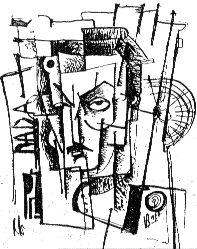
Mostly known as a painter and a Dada founder, he studied architecture at ETH in Zurich (1914 - 1919) and, together with his brother Juliu, practiced architecture in Romania only, from 1922 to 1941 when he emigrated to Israel. More than 40 buildings (villas and apartment buildings, a sanatorium and a swimming area), mostly in Bucharest, have been documented until now.
Well informed and deeply connected with the new spirit of the epoch, he has always proved to be a daring challenger of the surrounding conservatism. In Zurich, along with Ball, Arp, Huelsenbeck and Tzara, he participated in the foundation of the Dada movement. In Bucharest, mainly as a co-editor and art-director of the avant-garde magazine Contimporanul (1922-1932), but also as a member of the editorial board of other avant-garde publications (1925, Arta si orasul) or as a professor of interior design at the private Academy of Decorative Arts, he behaved as an tireless promoter of the ideas of the Modern Movement. Therefore he played a decisive avant-garde part in the development of inter-war architecture in Romania, being "the first to turn the back to the sterile, exhausted mentality in this country", as his younger, outstanding contemporary G.M.Cantacuzino voiced it (G.M.Cantacuzino, Letter, in Contimporanul 96-98/1931). It was perfectly true, since Janco built in 1926 the first modernist house in Romania and was the first to introduce the modern urban villa. However, it was not Janco, but Horia Creanga who achieved the typological transformation of it.
Although Marcel Janco was deeply concerned with the theoretical and ideological issues of the Modern Movement, his architecture escaped dogmatism: it is not designed as a rigorous manifesto. It rather stands under the sign of plurality and spontaneity, and most of all under his aim at achieving a Gesamtkunstwerk. Thus, behind the usual elements and proceedings of modernism, freely borrowed from different isms (from Expressionism to Neo-plasticism), in the best examples of his architecture (as the villa Juster showed in the photograph) one could detect a refined, intriguing eclecticism where the borders between architecture, interior design, painting and sculpture are suppressed. Since he was convinced that there is "a similar manner to achieve the architectural and painting composition", in his work the architectural approaches meet graphical and pictorial approaches obvious especially in the facade compositions, in the idiosyncratic way he models and dramatises the interior and exterior surfaces, in the application of graphic and chromatic schemes in order to complete a volume compositions or to decompose spaces, in the integration of plastic works (stained glass, base relief) in his projects.